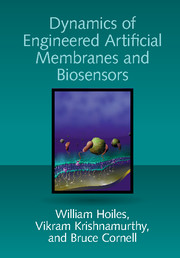Book contents
- Frontmatter
- Contents
- Preface
- List of Abbreviations
- Part I Introduction and Background
- Part II Building Engineered Membranes, Devices, and Experimental Results
- Part III Dynamic Models for Artificial Membranes: From Atoms to Device
- Appendices
- Appendix A Elementary Primer on Partial Differential Equations (PDEs)
- Appendix B Tutorial on Coarse-Grained Molecular Dynamics with Peptides
- Appendix C Experimental Setup and Numerical Methods
- Bibliography
- Index
Appendix C - Experimental Setup and Numerical Methods
from Appendices
Published online by Cambridge University Press: 25 May 2018
- Frontmatter
- Contents
- Preface
- List of Abbreviations
- Part I Introduction and Background
- Part II Building Engineered Membranes, Devices, and Experimental Results
- Part III Dynamic Models for Artificial Membranes: From Atoms to Device
- Appendices
- Appendix A Elementary Primer on Partial Differential Equations (PDEs)
- Appendix B Tutorial on Coarse-Grained Molecular Dynamics with Peptides
- Appendix C Experimental Setup and Numerical Methods
- Bibliography
- Index
Summary
This section details the precise ambient conditions and hardware specifications under which all experiments reported in this book were conducted. §C.1 provides the parameters for the ion-channel switch (ICS) biosensor experiments. §C.2 provides the experimental parameters estimated for the pore formation measurement platform (PFMP) for the dynamics of peptidyl-glycine-leucine-carboxyamide (PGLa) pore formation. §C.3 provides the experimental parameters of the electroporation measurement platform (EMP) model. Finally, §C.4 through §C.5.1 discuss coarse-grained molecular dynamics (CGMD) and molecular dynamics (MD) simulation parameters.
Channel Switch Biosensor
All experimental measurements, unless otherwise stated, were conducted at 27◦C in a phosphate-buffered solution with a pH of 7.2, and a 0.15Msaline solution composed of Na+, K+, and Cl−. At this temperature the tethered membrane is in the liquid phase. A pH of 7.2 was selected to match that typically found in the cellular cytosol of real cells. The forward and reverse reaction rates in Table C.1 are obtained from [220, 221, 283]. In Table C.1, notice that the computed diffusion coefficient for ferritin is 80 μm2/s and that for hCG is 250 μm2/s; this is an expected result because the ferritin has a molecular weight of 450 kDa and hCG a molecular weight of 25.7 kDa.
The governing equations (10.10), (10.12), (10.13), and (10.15) with the boundary conditions (10.11) are solved numerically with the commercially available finiteelement solver COMSOL 4.3a (Comsol Multiphysics, Burlington, MA). To solve the advection-diffusion equations (10.10) and (10.15) the COMSOL module Transport of Diluted Species is used. The surface reaction diffusion equation (10.13) is solved using the Weak Form Boundary PDE module. The simulation domain is meshed with approximately 46,000 triangular elements constructed using an advancing-front meshing algorithm. The generalized Poisson–Nernst–Planck and Poisson–Nernst–Planck are numerically solved using the multifrontal massively parallel sparse direct solver [14] with a variable-order variable-step-size backward-differential formula [53]. The Levenberg– Marquardt algorithm (10.17) is implemented using the MATLAB function lsqnonlin with (10.16) computed from the results of the COMSOL simulations.
- Type
- Chapter
- Information
- Dynamics of Engineered Artificial Membranes and Biosensors , pp. 412 - 420Publisher: Cambridge University PressPrint publication year: 2018



